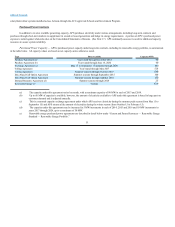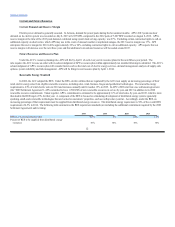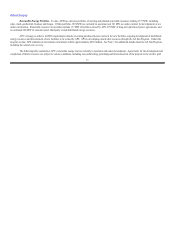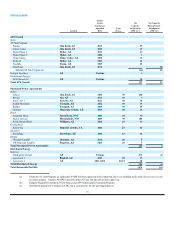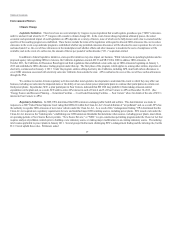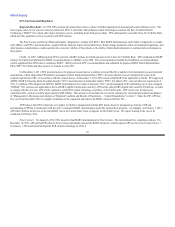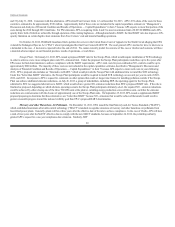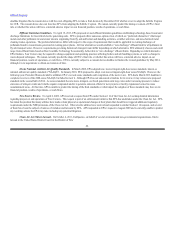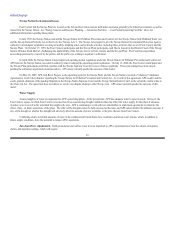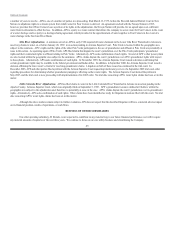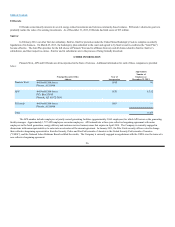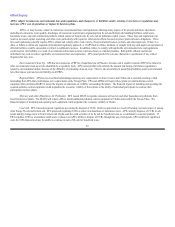APS 2013 Annual Report Download - page 23
Download and view the complete annual report
Please find page 23 of the 2013 APS annual report below. You can navigate through the pages in the report by either clicking on the pages listed below, or by using the keyword search tool below to find specific information within the annual report.
Table of Contents
and 5 by July 31, 2018. Consistent with this alternative, APS retired Four Corners Units 1-3 on December 30, 2013. APS’s 63% share of the costs for these
controls is estimated to be approximately $350 million. Approximately half of these costs are included in the capital expenditure estimates in “Management’s
Discussion and Analysis of Financial Condition and Results of Operations — Capital Expenditures” in Item 7 because APS expects to incur that portion of the
costs during the 2014 through 2016 timeframe. For PM emissions, EPA is requiring Units 4 and 5 to meet an emission limit of 0.015 lb/MMBtu and a 20%
opacity limit, both of which are achievable through operation of the existing baghouses. Although unrelated to BART, the final BART rule also imposes a 20%
opacity limitation on certain fugitive dust emissions from Four Corners’ coal and material handling operations.
On October 22, 2012, WildEarth Guardians filed a petition for review in the United States Court of Appeals for the Ninth Circuit alleging that EPA
violated the Endangered Species Act (“ESA”) when it promulgated the final Four Corners BART FIP. The court granted APS’s motion for leave to intervene as
a defendant in the case. A decision is expected before the end of 2014. We cannot currently predict the outcome of this case or whether such outcome will have
a material adverse impact on our financial position, results of operations, or cash flows.
Navajo Plant. On January 18, 2013, EPA issued a proposed BART rule for the Navajo Plant, which would require installation of SCR technology
in order to achieve a new, more stringent plant-wide NO emission limit. Under the proposal, the Navajo Plant participants would have up to five years after
EPA issues its final determinations to achieve compliance with the BART requirements. APS’s total costs for post-combustion NO controls could be up to
approximately $200 million. The majority of these costs are not included in the capital expenditure estimates described in “Management’s Discussion and
Analysis of Financial Condition and Results of Operations — Capital Expenditures” in Item 7 because APS expects to incur such costs in years following
2016. EPA’s proposal also includes an “Alternative to BART,” which would provide the Navajo Plant with additional time to install the SCR technology.
Under this “better than BART” alternative, the Navajo Plant participants would be required to install SCR technology on one unit per year in each of 2021,
2022, and 2023. In response to EPA’s request for comments on other options that could set longer time frames for installing pollution controls if the Navajo
Plant can achieve additional emission reductions, on July 26, 2013, a group of stakeholders, including SRP, the operating agent for the Navajo Plant,
submitted to EPA two suggested alternatives to BART, which would achieve greater NO emission reductions than EPA’s proposed BART rule. If the rule is
finalized as proposed, depending on which alternate operating scenario the Navajo Plant participants ultimately select, the required NO emission reductions
could be achieved by either closing one of the three 750 MW units at the plant or curtailing energy production across all three units, such that the emission
reductions are commensurate with the closure of approximately one of the Navajo Plant units. On September 25, 2013, EPA issued a supplemental BART
proposal proposing to determine that these alternatives are “better than BART” because NO emissions that would be achieved thereunder would result in
greater reasonable progress toward the national visibility goal than EPA’s proposed BART determination.
Mercury and other Hazardous Air Pollutants. On December 16, 2011, EPA issued the final Mercury and Air Toxics Standards (“MATS”),
which established maximum achievable control technology (“MACT”) standards to regulate emissions of mercury and other hazardous air pollutants from
fossil-fired power plants. Generally, plants will have three years after the effective date of the rule to achieve compliance. In the case of Cholla, APS will have
a total of four years after the MATS’ effective date to comply with the new MACT standards, because on September 24, 2012, the permitting authority
granted APS’s request for a one-year compliance date extension. Similarly, SRP
20
x
x
x
x
x



